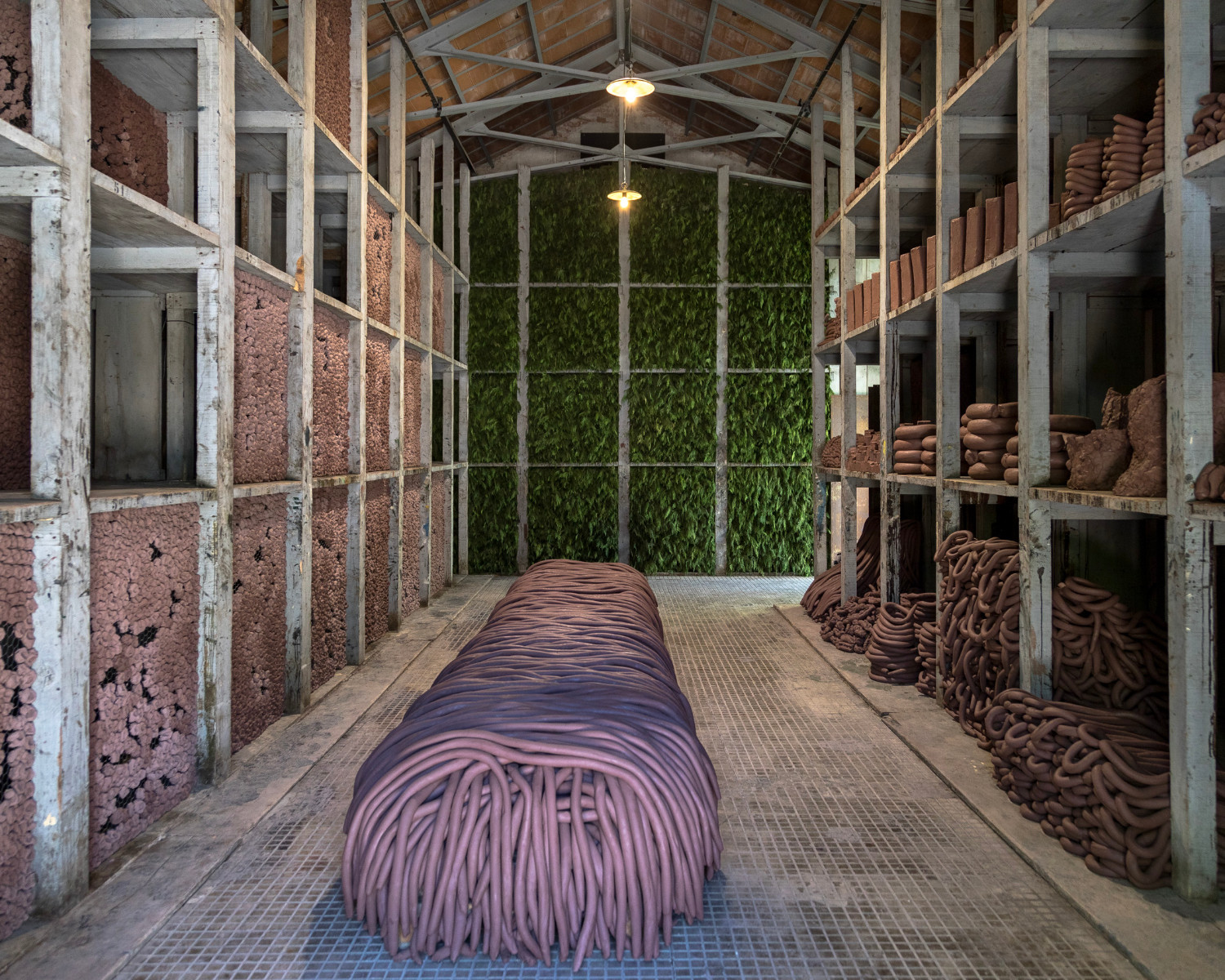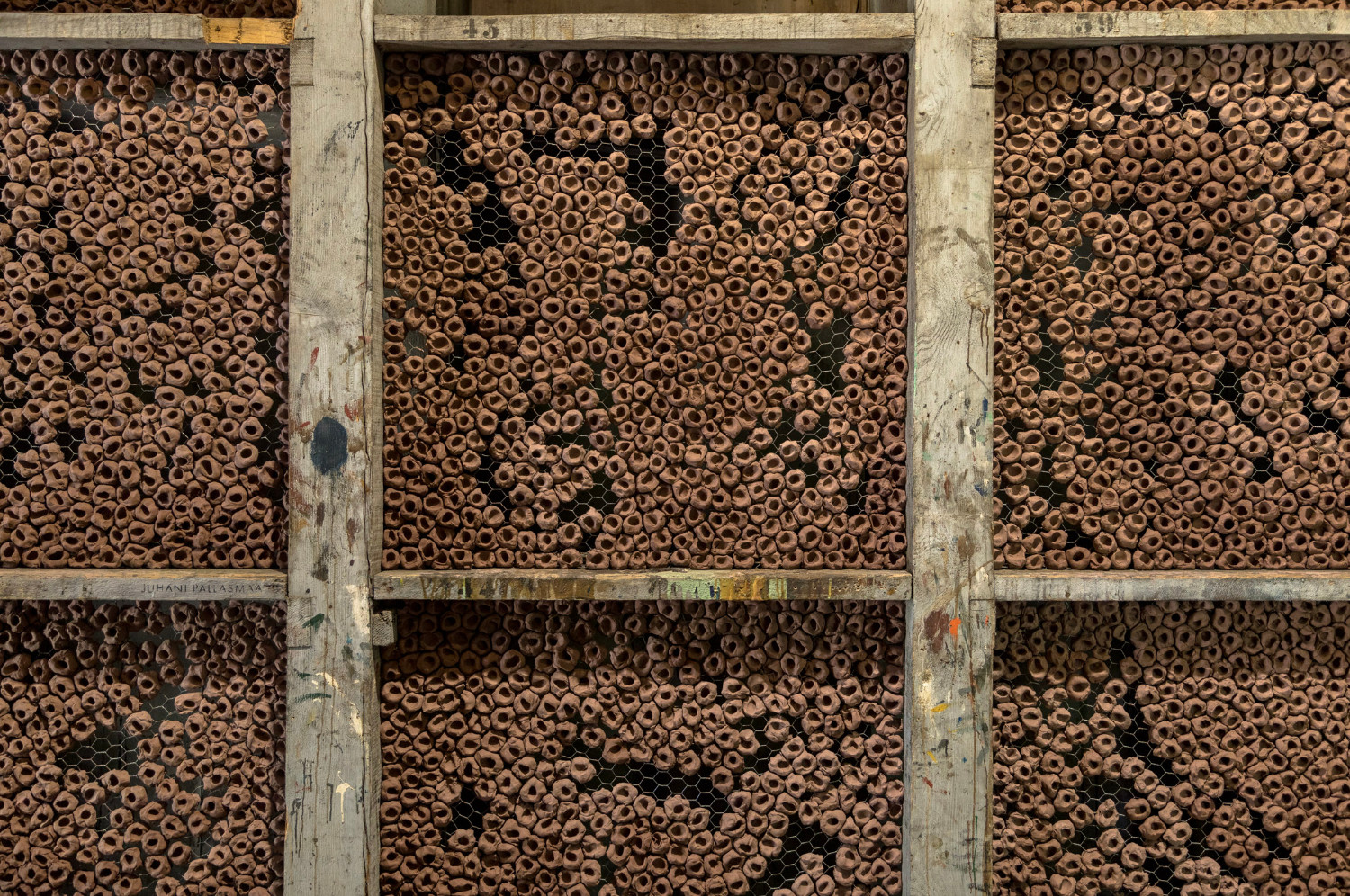

Emigrating from Italy to South America, first to Venezuela and then to Brazil, where she now resides, Maiolino embodies in many ways the spirit of “Foreigners Everywhere” by Adriano Pedrosa. At the Arsenale (Corderie and Giardino delle Vergini), one of her new large-scale works continues and develops the series of her clay sculptures and installations.
We need a revolution driven by love and by sharing with others. I was very happy with the title of my exhibition at the PAC in Milan, O amor se faz revolucionário, because love is revolutionary. There is no need for weapons if you respect and pay attention to others.
Foreigners Everywhere, but does that also mean that we can feel at home everywhere? Displaced identity and/or split identity? It also makes me think of a phrase by Marguerite Yourcenar who in the Memoirs of Hadrian has the emperor say: “The true birthplace is that wherein for the first time one looks intelligently upon oneself”.
We certainly need to look at ourselves to understand ourselves during our life. The answer to this question is difficult because identity is always changing, conditioned largely by the culture in which one finds oneself living and by one’s age. For a pre-adolescent 12-year-old – which was how old I was when I left Italy – it’s difficult to process everything that happens and to consider the situations, the transitions and the various stories that happen in a life. And now that I am 82, I know that time needs to pass and that we need to reach maturity to truly understand ourselves. Perhaps this is what Hadrian means about birthplaces in Memoirs of Hadrian. This is what can happen if as an adult you arrive in a place other than your native land. And perhaps I can say that my continent is my art; that is where I found refuge and it is with it that I identify.
Themes of memory, roots and origins in your work serve to highlight what we have in common as human beings. How have these themes evolved over time and what are your main sources of inspiration?
I let myself be guided by my feelings and by the richness of my memories. The beauty of my past in Scalea, the memories of my birthplace, of my childhood, the smells and flavours: these feelings and memories are at the heart of my work – they are the foundations and motivations from which I begin. My work is a combination of subjectivity and intellect. The various aspects of memory have fuelled my work and, as I said before, art has been my home, my homeland, my continent.

I read in one of your interviews that you tried to stay away from Italy even when you had to set up an exhibition in Europe. Then there was the solo exhibition at the PAC in Milan, the work at the MAXXI in Rome and now the Biennale. Have you forgiven this “mother” who allowed you to leave? And how have your personal history and your Brazilian-Italian background influenced your artistic practice?
I’ve never had to forgive the land where I was born. Life has been generous to me, and look where I’ve arrived, receiving the Golden Lion for Lifetime Achievement at the Venice Biennale! But I have never forgotten the hardships that, like many Italians, my family and I had to face as a result of the Second World War. Likewise the fact that my family was forced to emigrate. Those who are happy in their homeland don’t leave. Engaging with other cultures and other languages involves a lot of difficulties; we lose our initial identity, the one that was shaped in the place where we were born. It was many years before I could return to Italy. It wasn’t a matter of willpower, it was mainly that I didn’t have enough money to travel. I only returned to Italy when my work took me to Europe. I felt the need to revisit Bari and Milan, two cities that played important roles in my biography. And then, of course, I also visited the town where I was born. In 1945, after the war was over, I was only three years old. Even though I was very small, I could sense the conflicts in the post-war years that afflicted the adults and the economic difficulties of my family. In a way these difficulties determined my choices and my destiny because they led me not to stay in Scalea. I wasn’t one of those teenagers who could travel around discovering the beauties of Italy. We also lived in Bari – a more ‘on-the-outskirts’ Bari than the Bari of today – where I attended a primary school in the countryside. I’ve never really been able to participate in Italian cultural life. Many aspects of the human being are crucial for carrying out artistic work. The subjective part is the enormous baggage of the unconscious and I’m sure that in my case it has contributed to determining certain aspects of my sensibilities and my way of expressing myself through art. I always say that I am “a defective Italian”. Atavistically I react like a Calabrian and I’m proud to be southern, but, yes, I’m a defective Italian. I believe that all those who, from 1870 on, emigrated like my grandfather Biagio, who left Calabria at the age of thirteen, feel this sensation of being defective Italians, inadequate over time. We are outside of time.
We often feel inadequate even in our own country. As regards art, for example, here in Italy the ethical discourse of civic commitment has been neglected…
We need a revolution driven by love and by sharing with others. I was very happy with the title of my exhibition at the PAC in Milan, O amor se faz revolucionário, because love is revolutionary. There is no need for weapons if you respect and pay attention to others. I try to get my grandchildren to focus their attention on the world and on other people, but what do they do? They’re always on their phones… If I think about it, it almost makes me want to cry. But then I say to myself “No Anna, you’re the one who’s inadequate, you’re the one who’s out of time”. I don’t know if I’m happy to be out of time. But life has been generous to me and has let me get to almost 82 years old. So maybe that’s okay.
I can say that my continent is my art; that is where I found refuge and it is with it that I identify
The minor arts and popular culture have always been part of your artistic practice, offering extreme freedom of expression. Your drawings, woodcuts, paintings, sculptures, photographs, videos and installations have in fact created a composite and sophisticated creative vocabulary, which has moved from matter to form and vice versa. What formal research and what evolution guided your artistic hand? How would you summarise your language?
This question demands concrete answers. I leave the definition of my art and my language to critics and historians. It is difficult to summarise sixty-four years of work and define all the areas in which my work has developed over six decades. My artistic hand was guided by immense curiosity and an inexhaustible desire to experiment.
Body and mind, cerebral thought and emotional thought are the points through which your art and your life have passed – points which in the mouth and in the act of eating (anthropophagia) found the tools for freeing oneself from one’s own demons, to face them, destroy them and find one’s freedom again. In your work there is a life-death dichotomy. It seems to evoke questions relating to the individual and the individual’s limitations through the materials you use. What are today’s new demons?
At almost 82 years old I find myself faced with profound reflections on time. I really wish my art could reflect who I am today. Art has been my great interlocutor and in it I have always found answers about my identity and to the complex questions of life – questions that demand answers. However, in these difficult and contradictory times I doubt that answers to such individual questions can be found. Wars, violence, the rise of far right politics, hunger, issues related to immigration: those are my contemporary demons. I have often been inspired by the anthropophagic concept of the ancient Brazilian Indians, which consists in defeating and eating the enemy. Long assimilated into Brazilian art, this concept has also influenced some of my work dating back to the early 1970s: poems, writings and performances that use soundscapes and preverbal sounds. For my installation Andando e venendo at the Biennale, I prepared a text in Portuguese entitled Uma estória. It is not a true story but rather a tale inspired by the invented stories that my grandfather told me. In front of his house in Scalea there was the Torre Talao Tower and below it the caves where hominids lived about 60,000 years ago. Grandfather Biagio made up stories about these ancient “relatives” (as he called them) and I invented this story to reflect on the ugliness of the world. Through poetry, art offers a wonderful form of resistance to tragedy.

Your work is not explicitly feminine or feminist, but the narrative voice is clearly female. It addresses everyday life, food, the memory of the origin, the tactile, and the proliferation of life through repetition and difference. For several weeks, the Sunday supplement of “Il Sole 24 Ore” has given space to artists who explore themes such as the role of the artist today and civil commitment (which for many has not represented a priority). Personally, I believe that female artists have always shown greater courage than their colleagues in tackling civil and ethical issues. Do you share this belief?
I have always worked alone and my reflections concern that which surrounds me. In the 1960s my work was linked to women’s everyday life, because I perceived a sort of male hierarchy in the production of art. I don’t want to think in stereotypes, but I would rather compare my experience to that of a Neapolitan taxi driver who speaks in metaphors: in this I feel Italian, I speak metaphorically. I perceived that through metaphors I could talk about everyday life and resist the hegemonic imposition of male production supported by the art market. This was an Anna who believed she had to express herself without being biased, without excluding others. It is important to express the feelings of your gender, which connect to humanity because feelings are the same in men and women, like in all human beings everywhere. For me it is important to express myself as a mother, as a woman and also as a woman who carries out the daily work of managing my household. Resisting market pressure goes beyond mere sales and is about expectations. Probably the fact that women have been kept away from all forms of civic engagement and treated as minors throughout history (in Italy they only obtained the right to vote in 1946) drove them to commit themselves to obtaining the recognition and rights they deserved. In Brazil even today they are the ones who guarantee the greatest support for families. And it takes a lot of courage to bring a child into the world. Women’s civil commitment has grown as they have worked more outside the home. Society needed women’s work and so women emancipated themselves. Only if you leave the home do you come into contact with civil issues, salary problems and all the rest. Yes, it’s true, women today are showing great courage in expressing themselves, and this is becoming increasingly evident.